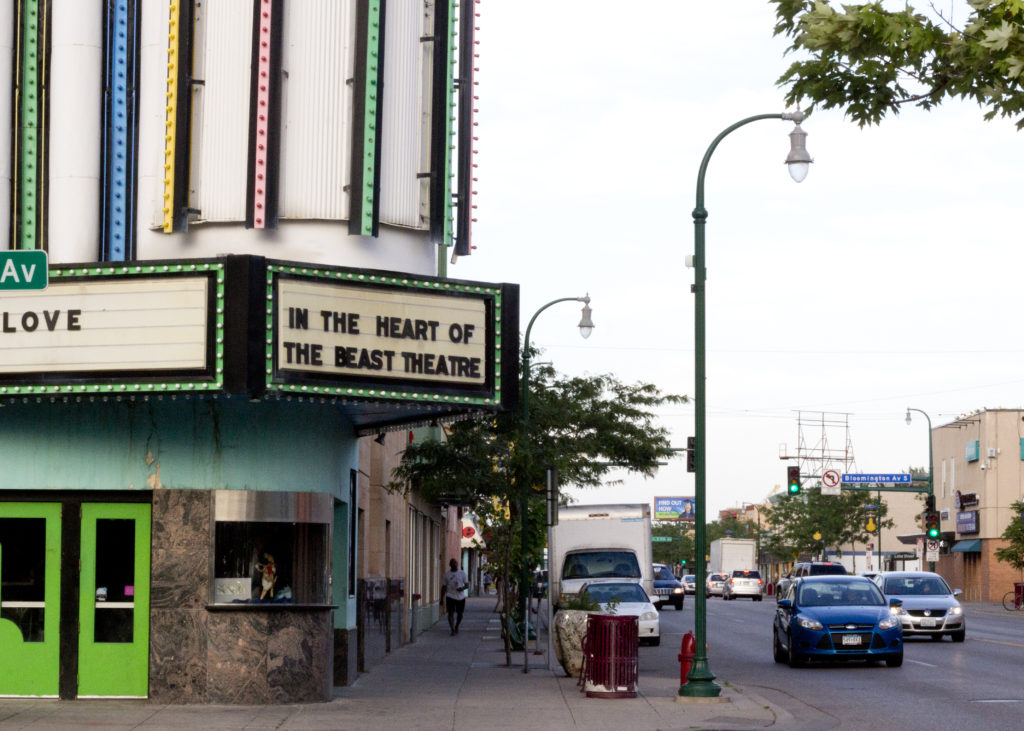
BY LINDSEY FENNER
“This is the place”
The sparkling Kasota stone façade catches the hot summer sun, reflecting back the colorful buildings nearby: mint-green; peach-pink; and the green, red, and yellow traffic lights of this busy and vibrant stretch of South Minneapolis. A mural meets the stone at the round white and black striped marquee, accented with strips of neon color, at the corner of 15th Avenue South and Lake Street. The marquee is a landmark on a bustling street, an Art Deco vision of the future, a tower of human light reaching to the sky.
Inside, the lobby is a cool respite from the heat. The building is quiet, between the busy MayDay build, and the fall and winter stage shows. The green-trimmed doorways are framed with a Pete Seeger quote. A long table along the length of the lobby is bare, except for a paper-mache blue jay head and a pair of hands, each much larger than life. At one end of the lobby is a shrine and thank you for the gift of water: a humble water fountain, set in a niche of swirling blue glass mosaic, and a mural of the connections and the life that come from water. Another mural decorates the north wall of the lobby, rays of life joining at a yellow sphere. The center of the sphere reads, “This is the place.” This is the Avalon Theater, the place where In the Heart of the Beast Puppet and Mask Theatre has made its home since 1988.
Difficult Decisions
Recently, HOBT has begun the process of deciding whether it should stay in the Avalon or find another space to continue its work in the Phillips and Powderhorn neighborhoods. The theater, built in 1924 as a movie theater, is showing both its age and its limitations as a work and teaching space for the theater company. Extensive repairs would be needed to bring the building up to code and to better serve the needs of HOBT.
A building assessment done in 2015 estimated the repairs would cost approximately 2.5 million dollars, according to HOBT Executive Director Corrie Zoll. The improvements needed include making the building more physically accessible; upgrading HVAC systems; replacing aging seating, sound, and lighting equipment; and improving office, meeting, storage and classroom spaces. Leaving the Avalon would also require significant capital and work. A new space would have to be found that fit the needs of the company and would most likely need renovation. Moving, after nearly thirty years in one place, would be a costly undertaking. A change this consequential would also probably disrupt HOBT”'s performance and education activities. HOBT is trying to weigh which option, staying or leaving, would best allow it to fulfill its mission.
The Avalon, built as a movie theater, does not have many of the necessities for live performance. There is no catwalk to safely access theater lights, there are no wings for entrances and exits, no true backstage, and limited space for storage. With the seating removed, the performance space doubles as a giant community workshop during preparations for the MayDay celebration. But the seating is cumbersome to move, and the slanted floor makes for less than ideal working conditions. Changes such as installing a catwalk, making the floor level, and getting new, more flexible seating would greatly improve the performance space, according to Sandy Spieler, Director of MayDay and one of the founders of HOBT.
The second and third stories have been converted from their movie theater origins to fit the needs of the company. The former movie “crying room,” a space for families to bring crying children while still watching the movie through a glass window, is now a place for transformation and creation. Stacks and shelves of puppet-making supplies: clay, paint, newspapers, cardboard, cover nearly every inch of wallspace in the workshop. The tiny third-floor serves as the fabric room, bursting with colors and textures, with a corner devoted to storing the archival memories of HOBT.
Deep Roots
The Avalon has been at the center of these memories for almost thirty years, fittingly located at the boundary of Powderhorn and Phillips, the two neighborhoods where HOBT has deep roots. The theater company began in 1973 as the Powderhorn Puppet Theatre, founded by David O”'Fallon and Ray St. Louis. First working out of a tiny space in the basement of Walker Church at 31st St. and 16th Avenue South, and later several storefronts along Lake Street (including the demolished Gustavus Adolphus lodge building and above the recently departed Roberts”' Shoes), the puppet and mask troupe performed its first shows in Powderhorn Park and celebrated its first MayDay in 1975. Inspired by the work of Bread and Puppet Theatre in Vermont, HOBT uses simple materials to achieve its mission:Â “to bring people together for the common good through the power of puppet and mask performance.”
The name “In the Heart of the Beast” came in 1979 from company member and poet Steven Linsner, who, inspired by a Jose Marti quote, wrote “To be puppeteers in the Heart of the Beast…is to find ourselves in the great world Beast made of families, races, ages, sexes, classes, corporations and nations, people, (and creatures!) all different, working out a way to live together.”
By the mid-1980s, HOBT used many venues for their shows: public spaces like parks, streets, and rivers; touring shows across the region; the sanctuary of Walker Church; their third-story space above Roberts”' Shoes. The need for a more permanent, larger space became apparent when a performance in the latter was shut down by the fire marshal.
Spieler described the Lake Street of the 1980s as having the same feeling of “raw vitality” it does today, but with a different variety of languages spoken and more empty storefronts. When HOBT was looking for a new space, there were a few options in the neighborhood besides the Avalon, including an empty building across 15th Avenue where the Kaplan Brothers store would also find a new home in 1988. But the Avalon seemed to be the best fit, since as a theater, it was already zoned for public performances. It also had a name which fit as a metaphor for the transformative creativity HOBT shared with the community.
“An Act of Faith”
Around the time HOBT was moving into the Avalon, Spieler had a dream “in which throngs of wounded people lined up on Lake Street– standing with crutches, being carried on stretchers, all waiting to go into the Avalon as a sanctuary, a place of healing. I had just researched Avalon”'s place in English lore: at the center of the island of Avalon there was a fountain that healed wounded warriors with the Water of Life. This dream spoke to our intent that our new home on Lake Street be a place of vitality for participatory community creativity.”
But the Avalon in the ”˜80s was ugly with neglect. Built in 1924, it had been remodeled and expanded in 1937, with the streamlined Art Deco exterior of Kasota stone, and the bold marquee, bringing a modern look to Depression-era Lake Street. The theater continued to show family-friendly movies and later, art film, until the late 1950s. The loss of the streetcar line along Lake Street in the 1950s led to hard times for the theater, and pornographic fare began to take over. By the 1970s and ”˜80s, Lake Street struggled with crime and seedy X-rated businesses like the Avalon and a nearby adult bookstore. Through efforts of the neighborhood, the theater closed in 1984 and stood vacant until HOBT came to transform it in 1988.
Acquiring the theater was an “act of faith,” said Spieler, faith that people would stop at that corner on Lake Street, faith that something that had become ugly could be beautiful again. Revitalizing the dilapidated theater took the hard work of the community. Spieler described the then orange interior walls as “dripping with mold.” Led by Partners Three Company (the construction business of Alley Editor Harvey Winje, and partner and community activist Susan Gust), volunteers put in countless hours of work alongside of paid contractors restoring the space. When a potential deal with the city to purchase the theater fell through, HOBT rented the Avalon for several years. HOBT, supported financially in part by the Minneapolis Community Development Agency, and neighborhood groups from Powderhorn and Phillips, finally purchased the building in 1990. The theater company has raised over one million dollars to purchase and renovate the building.
Committed to Community
The Avalon has served as a home to HOBT and a hub of community creativity, but the work of HOBT has always extended beyond the confines of a street address. The MayDay Parade and Festival joins Phillips and Powderhorn in an annual spring ritual of transformation. Touring shows bring puppet and mask theater into communities around the state and around the world. The Phillips Project, now in its fifth year, engages youth in the Phillips neighborhood through artist residencies at Waite House, Little Earth of United Tribes, and Project for Pride in Living”'s Collaborative Village Initiative. This work would not end if HOBT decides to leave the Avalon, according to HOBT Executive Director Zoll.
The community understands the importance of HOBT to the neighborhood. “Personally,” Jana Metge, Midtown Phillips Board Member, said “I believe it would be disastrous to lose HOBT at this corner. It brings life and energy to the intersection and to our neighborhood. Many times here in Phillips a child”'s first experience with Art and/or Theatre are projects through HOBT.”
Lake Street Council Executive Director Allison Sharkey said the theater company “is a tremendous asset to the Midtown community. We are prepared to provide any support we can to help keep HOBT here while ensuring the organization”'s ability to thrive.”
If HOBT does leave the Avalon, they wouldn”'t want the dearly loved theater to become condos or offices, but to remain a social space for people to be together, Spieler said. One possibility might be for multiple arts organizations to share the Avalon as a performance venue. HOBT might then find a nearby place in the community with sufficient workshop and teaching space, but still be able to use the Avalon for stage shows. HOBT is at the beginning of making this difficult choice, and is open to creative suggestions from the community. No matter what happens, said Spieler, “In the Heart of the Beast is absolutely committed to these neighborhoods.”














